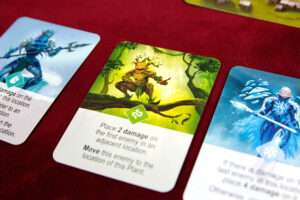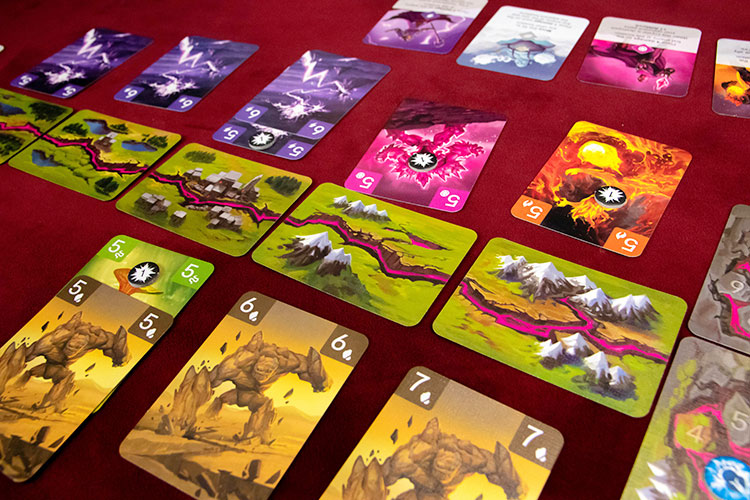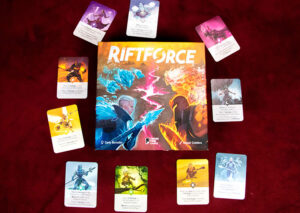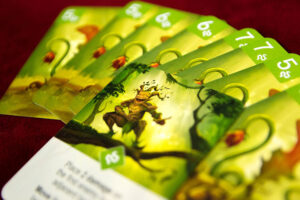 I love two-player only games. The battle back and forth, one on one, trying to out strategize your opponent. No need to worry about king-making or negotiation or someone trying to get back at you for the stunt you pulled in a game of Oath three months ago. Your enemy is clear and right in front of you.
I love two-player only games. The battle back and forth, one on one, trying to out strategize your opponent. No need to worry about king-making or negotiation or someone trying to get back at you for the stunt you pulled in a game of Oath three months ago. Your enemy is clear and right in front of you.
Unfortunately, I don’t get to play a lot of them. I don’t have another gamer in the house, unless my 8-year-old can pick up the rules. But occasionally a player will arrive early or stay a bit late and that’s about the extent of my two-player games. So, I really appreciate when a game can pack some strategy and depth in less than an hour. Enter, Riftforce. Does it live up to all the hype from these last two paragraphs?
Gameplay Overview:
To see the game on the table, you’d almost certainly first compare Riftforce to Battle Line or Schotten Totten. It has a similar look of a center row with cards representing areas and players deploying cards to them. But these are rifts, not battlefields and elementals, not soldiers.
Riftforce begins with a draft of the different elemental guilds. There are ten different guilds with unique powers. Each player will be given one randomly to start and a third will be discarded back into the box. From there, players will take turns drafting from the remaining guilds until they both have four. Then, you’ll take the deck of elementals for all your drafted guilds and shuffle them together.

Each guild’s deck looks the same. Two 7-value elementals, three 6’s, and four 5’s. The guild’s summoner card outlines their power. On your turn you have three options:
- Play up to 3 elementals. They must all be the same element or the same number. You can play all to a single rift or one each to three adjacent rifts.
- Activate up to 3 elementals. Discard a card and activate up to three cards who have the same number or the same suit. Each different elemental guild has a different power when activated.
- Check and draw. Check if there are any rifts where you have an elemental, and your opponent doesn’t. If so, score 1 point for each such rift. Then draw up to 7 cards.
The other way to score points is to destroy your opponent’s elementals. You’ll score a point each time you do. Each elemental can take damage equal to its printed number. So, when your 5-value elemental has 5 damage, it’s dead. Each different elemental does damage in a unique way when activated. For instance:
- Air elementals move when activated and do 1 damage to the first enemy at its new location and adjacent locations.
- Plant elementals deal 2 damage to an adjacent enemy and pull them to their rift.
- Shadow elementals move and each one damage. If that damage kills the enemy, they earn an extra point.
The game continues until a player has earned 12 points. After an equal number of turns whoever then has the most points wins.

Game Experience:
So, is Riftforce the less than an hour but still pretty strategic 2-player experience I want? Honestly, yeah. Pretty much. It’s a little bit of a long teach, since every elemental type must be reviewed, but once you know the game it plays pretty close to 30 minutes.
The beginning draft reminds me a lot of how a game of War Chest plays out. Players will try to draft guilds who have powers they think can work together well. Maybe you try to go the agile route—take the Air, Water, and Shadow elements and try to stick and move. Fill in the gaps where you can and try to steal a few extra points with the “check and draw” actions.

Or take the Crystal guild. They deal four damage when activated, way more than any other elementals. But when they die your opponent scores a bonus point. But if you also draft the Light elementals, you’ll be able to heal them as they take damage. There are only ten guilds, so the combinations aren’t necessarily endless, but they are plentiful. And from play to play you can learn the combinations your opponent has had success with and hate draft them away and force both of you into new strategies.
Of course, the game doesn’t end with the draft. If there is a weak part of Riftforce, it’s the first few turns. To start the game, the second player gets to add a random elemental from the top of their deck to the middle rift. So, the first player will then normally deploy elementals to the middle and its adjacent rifts. Forcing the second player to deploy in a way that they also have presence of those rifts to avoid giving away free points. It’s all a little rote.

But there are still quite a bit of decisions in what to deploy and that does set the stage for the rest of the game. If you deploy all your cards of a given element you may have a hard time activating them later. The same is true of deploying all your 6-value cards and not being able to watch them in action. It’s a delicate balance of maintaining a presence in each rift and wearing down your opponent’s elementals to score. Now maybe you’ll just get lucky and draw all the cards you need to make effective attacks but leaving it up to the heart of the cards is a dangerous option.
This, of course, becomes even more pronounced during the mid-game. If you have one rift without an opponent present, do you take the check and draw action to bank that free point before they can redeploy? If you are running low on cards the answer is probably yes. But what if you already have six cards and will only get to draw one more? Points are great and all, but you give up a lot of tempo that could come back to haunt you, opening the window for your opponent to kill your elementals or heal theirs.
All this basically drives to the same point. I’m over 10 plays in on Riftforce and I’m still not sure what the best combinations are. I’m not sure how to make the most of each interaction. While there is certainly value in taking full advantage of your guilds’ powers, you really must manage your hand well to take full advantage. Or just draw the right card at the right time. Maybe a little bit of both.
Final Thoughts:
My shelf of two-player only games is pretty sparse. Even some of my favorites, like Sekigahara, have left my collection just because the opportunity to play a 3+ hour game with just one other player never arises. Riftforce, however, is going to stick around for now.
Of course, it doesn’t have all the strategic depth of a full-on war game. There is plenty of randomness in drawing the right cards. But it still manages to reward careful planning, smart decisions, and finding the right balance between deploying all your cards and keeping them in reserve to make them fight.
Final Score: 4 Stars – Great beginning of the game draft that leads into a tense, tactical 2-player battle.
 Hits:
Hits:
• Lots of different combinations of elementals to draft with unique powers.
• Once taught, packs a lot of decision making into thirty minutes.
• Being able to score points by positioning, as well as damage, adds a layer of strategy especially to which guilds are drafted.
Misses:
• For the first play it takes almost as long to teach as to play.
• First few turns of the game feel a bit lackluster. But picks up once both players get some elementals in play.






















